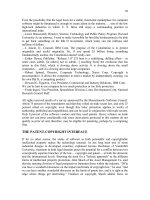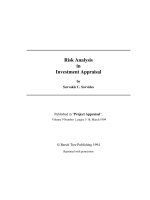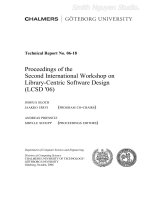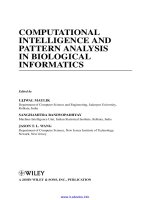Risk Analysis in Software Design
Bạn đang xem bản rút gọn của tài liệu. Xem và tải ngay bản đầy đủ của tài liệu tại đây (97.58 KB, 6 trang )
Building Security In
Editor: Gary McGraw,
Risk Analysis
in Software Design
R
isk analysis is often viewed as a “black art”—part
fortune telling, part mathematics. Successful risk
•
analysis, however, is nothing more than a business-level decision-support tool: it’s a way of gath-
ering the requisite data to make a good judgment call based on
•
DENIS VERDON
Fidelity
National
Financial
GARY
MCG RAW
Cigital
knowledge about vulnerabilities,
threats, impacts, and probability.
Established risk-analysis methodologies possess distinct advantages
and disadvantages, but almost all of
them share some good principles as
well as limitations when applied to
modern software design. What separates a great software risk assessment
from a merely mediocre one is its
ability to apply classic risk definitions
to software design and then generate
accurate mitigation requirements. A
high-level approach to iterative risk
analysis should be deeply integrated
throughout the software development life cycle.1 In case you’re keeping track, Figure 1 shows you where
we are in our series of articles about
software security’s place in the software development life cycle.
Traditional
terminology
Example risk-analysis methodologies for software usually fall into two
basic categories: commercial (including Microsoft’s STRIDE, Sun’s
ACSM/SAR, Insight’s CRAMM,
and Cigital’s SQM) and standardsbased (from the National Institute of
Standards and Technology’s ASSET
or the Software Engineering Institute’s OCTAVE). An in-depth
analysis of all existing methodologies
is beyond our scope, but we’ll look at
32
PUBLISHED BY THE IEEE COMPUTER SOCIETY
■
basic approaches, common features,
strengths, weaknesses, and relative
advantages and disadvantages.
As a corpus, “traditional” methodologies are varied and view risk from
different perspectives. Examples of
basic approaches include
• financial loss methodologies that
seek to provide a loss figure to balance against the cost of implementing various controls;
• mathematically derived “risk ratings” that equate risk with arbitrary ratings for threat, probability,
and impact; and
• qualitative assessment techniques
that base risk assessment on anecdotal or knowledge-driven factors.
Each basic approach has its distinctly different merits, but they almost all share some valuable concepts
that should be considered in any risk
analysis. We can capture these commonalities in a set of basic definitions:
• The asset, or object of the protection efforts, can be a system component, data, or even a complete
system.
• Risk, the probability that an asset
will suffer an event of a given negative impact, is determined from various factors: the ease of executing an
attack, the attacker’s motivation and
1540-7993/04/$20.00 © 2004 IEEE
■
•
•
resources, a system’s existing vulnerabilities, and the cost or impact
in a particular business context.
The threat, or danger source, is invariably the danger a malicious
agent poses and that agent’s motivations (financial gain, prestige, and
so on). Threats manifest themselves
as direct attacks on system security.
A vulnerability is a defect or weakness in system security procedure,
design, implementation, or internal control that an attacker can
compromise. It can exist in one or
more of the components making
up a system, even if those components aren’t necessarily involved
with security functionality. A given
system’s vulnerability data are usually compiled from a combination
of OS- and application-level vulnerability test results, code reviews,
and higher-level architectural reviews. Software vulnerabilities
come in two basic flavors: flaws
(design-level problems) or bugs
(implementation-level problems).
Automated scanners tend to focus
on bugs, since human expertise is
required for uncovering flaws.
Countermeasures or safeguards are the
management, operational, and
technical controls prescribed for an
information system that, taken together, adequately protect the system’s confidentiality, integrity, and
availability as well as its information. For every risk, a designer can
put controls in place that either
prevent or (at a minimum) detect
the risk when it triggers.
The impact on the organization,
were the risk to be realized, can be
monetary or tied to reputation, or
it might result in the breach of a
law, regulation, or contract. With-
IEEE SECURITY & PRIVACY
Building Security In
out a quantification of impact,
technical vulnerability is hard to
handle—especially when it comes
to mitigation activities.
• Probability is the likelihood that a
given event will be triggered. It is
often expressed as a percentile, although in most cases, probability
calculation is extremely rough.
Although they start with these
basic definitions, risk methodologies usually diverge on how to arrive
at specific values. Many methods
calculate a nominal value for an information asset, for example, and attempt to determine risk as a function of loss and event probability.
Others rely on checklists of threats
and vulnerabilities to determine a
basic risk measurement.
Example of
a risk calculation
One classic risk-analysis method expresses risk as a financial loss, or annualized loss expectancy, based on
the following equation:
ALE = SLE × ARO,
where SLE is the single loss expectancy, and ARO is the annualized
rate of occurrence (or the predicted
frequency of a loss event happening).
Let’s consider an Internet-based
equities trading application with a
vulnerability that could result in
unauthorized access (the implication
being that unauthorized stock trades
can be made). Assume a risk analysis
determines that middle- and backoffice procedures will catch and
negate any malicious transaction
such that the loss associated with the
event is simply the cost of backing
out of the trade. We’ll assign a cost of
$150 for any such event, so SLE =
$150. With an ARO of just 100 such
events per year, the cost to the company (or ALE) will be $15,000.
The resulting dollar figure provides no more than a rough yardstick, albeit a useful one, for determining whether to invest in fixing
the vulnerability. Of course, for our
Security
requirements
Abuse
cases
Requirements
and use cases
External
review
Risk
analysis
Design
Static
analysis
(tools)
Risk-based
security tests
Test
plans
Penetration
testing
Risk
analysis
Code
Test
results
Security
breaks
Field
feedback
Figure 1. The software development life cycle. Throughout this series, we’ll focus on
specific parts of the cycle; here, we’re examining risk analysis.
fictional equities trading company, a
$15,000 annual loss might not be
worth getting out of bed for (typically, a proprietary trading company’s intraday market risk dwarfs
such an annual loss figure).
Other methods take a more qualitative route. In the case of a Web
server providing a company’s face to
the world, the Web site’s defacement
might be difficult to quantify as a financial loss (although some studies
indicate a link simply between security events and negative stock-price
movements2). In cases in which “intangible assets” are involved (such as
reputation), qualitative risk assessment might be a more appropriate
way to capture the loss.
Regardless of the technique used,
most practitioners advocate a return
on investment study to determine
whether a given countermeasure is
cost-effective for achieving the desired
security goal. Adding applied cryptography to an application server via
native APIs without the aid of dedicated hardware acceleration might be
cheap in the short term, for example,
but if it results in a significant loss in
transaction volume throughput, a better ROI might come from investing
up front in crypto acceleration hardware. Interested organizations should
adopt the risk-calculation methodology that best reflects their needs.
Common themes
Most risk-analysis process descriptions emphasize identification, rank-
ing, and mitigation as continuous
processes and not just a single step to
be completed at one stage of the development life cycle. Risk-analysis
results and risk categories tie in with
both requirements (early in the life
cycle) and testing (where developers
can use results to define and plan particular tests).
Because it’s a specialized subject,
risk analysis is not always best performed solely by the design team.
Rigorous risk analysis relies heavily
on an understanding of business impacts, which requires an understanding of laws and regulations as well as
the business model supported by the
software. Because developers and
designers build up certain assumptions regarding their system and the
risks it faces; at a minimum, risk and
security specialists should assist in
challenging those assumptions
against generally accepted best practice. They’re in a better position to
“assume nothing.”
Putting the right people together
for an analysis is important: consider
the risk team very carefully. Knowledge and experience cannot be
overemphasized because risk analysis
is not a science, and broad knowledge of vulnerabilities, bugs, flaws,
and threats is a critical success factor.
A prototypical analysis involves
several major activities that often include several basic substeps:
• Learn as much as possible about
the analysis target (substeps include
www.computer.org/security/
■
IEEE SECURITY & PRIVACY
33
Building Security In
Cigital’s approach
F
igure A illustrates Cigital’s continuous risk-analysis process, which loops constantly and at
many levels of description through several phases. In Cigital’s approach, business goals
determine risks, risks drive methods, methods yield measurement, measurement drives decision
support, and decision support drives fix/rework and application quality.
2
1
Understand
the business
context
Identfiy the
business risks
Artifact
analysis
Artifact
analysis
Business context
3
Identfiy the
technical risks
Technical
expertise
Measure
and report
4
Synthesize
and prioritize
the risks
5
Define the
risk mitigation
strategy
Artifact analysis
Initiate
process
improvement
Validation loop
7
6
Validate
the artifacts
Fix
the artifacts
Figure A. Cigital’s risk-management framework. Many aspects of frameworks
such as this can be automated—for example, risk storage, business risk to
technical risk mapping, and the display of status over time.
reading and understanding specifications, architecture documents,
and other design materials; discussing and brainstorming with
the group; determining system
boundary and data sensitivity/criticality; playing with the software if
it exists in an executable form;
studying the code and other software artifacts; and identifying
threats and agreeing on relevant
sources of threat).
• Discuss security issues surrounding
the software (substeps include arguing about how the product
works and determining areas of
disagreement; identifying possible
vulnerabilities, sometimes by using
tools or lists of common vulnerabilities; mapping out exploits and
discussing possible fixes; and gaining an understanding of current
and planned security controls).
• Determine the probability of
compromise (substeps include
mapping out attack scenarios for
vulnerability exploitation and bal34
IEEE SECURITY & PRIVACY
■
MAY/JUNE 2004
•
•
•
ancing controls against threat capacity to determine likelihood).
Perform impact analysis (substeps
include determining the impact on
asset and business goals and considering the impact on security).
Rank risks.
Develop a mitigation strategy (a
substep is recommending countermeasures to mitigate risks).
Report findings (substeps include
carefully describing major and
minor risks while paying close attention to impact, and providing
basic information about where to
spend limited mitigation resources).
eral threat categories during analysis.3 Similarly, Cigital’s SQM approach uses attack patterns4 and exploit graphs to understand attack
resistance, knowledge of design
principles for ambiguity analysis,5
and knowledge regarding commonly used frameworks (.NET and
J2EE being two examples) and software components.
A central activity in design-level
risk analysis is to build up a consistent
view of the target system at a reasonably high level. The idea is to see the
forest, not get lost in the trees. The
most appropriate level for this description is the typical “white board”
view of boxes and arrows describing
the interaction of various critical design components. The nature of software systems leads many developers
and analysts to assume (incorrectly)
that a code-level description of software is sufficient for spotting design
problems. Although this might occasionally be true, it does not generally
hold. Extreme programming’s claim
that “the code is the design” represents one radical end of this approach.
Without a white-board level of description, an architectural risk analysis is likely to overlook important
risks related to flaws.
Risk Analysis
and Requirements
Knowledge
Requirement
Previous articles in this series consider security requirements definitions and discuss abuse cases as a
method for generating requirements. In the purest sense, risk analysis begins at this point: design requirements should take into account
the risks you’re trying to counter.
Let’s look at three approaches to interjecting a risk-based philosophy
into the requirements phase (note
that the requirements systems based
on UML tend to focus more attention on security functionality than
they do on misuse and abuse cases):
Design-level analysis is knowledge
intensive. Microsoft’s STRIDE
model, for example, involves the understanding and application of sev-
• SecureUML (www.informatik.
uni-freiburg.de/~tolo/pubs/
secuml_uml2002.pdf) is a met-
•
The sidebar on Cigital’s solution
shows one commercial example that
follows this basic approach.
Building Security In
hodology for modeling accesscontrol policies and their integration into model-driven software
development. SecureUML is
based on role-based access control
and models security requirements
for well-behaved applications in
predictable environments.
• UMLsec (.
de/~umlsec/) is an extension to
UML that enables the modeling of
security-related features such as
confidentiality and access control.
• Guttorm Sindre and Andreas Opdahl6 attempt to model abuse cases
as a way of understanding how applications might respond to threats
in a less controllable environment;
they describe functions that the
system should not allow.
A key variable in the risk equation is impact. Business impacts generally boil down into three broad
categories:
• federal or state laws and regulations
(including the Gramm-LeachBliley Act, HIPAA, and the muchcited California Senate Bill 1386);
• financial or commercial considerations (such as revenue protection,
control over high-value intellectual property, and preservation of
brand and reputation); and
• contractual considerations (including service-level agreements
and avoidance of liability).
The first step to risk analysis at the requirements stage is to break down requirements into three simple categories: must haves, important to
haves, and nice but unnecessary. Unless you’re running an illegal operation, you should always class laws and
regulations into the first category—
these requirements should be instantly mandatory and not subject to
further risk analysis (although an ROI
study can help you select the most
cost-effective mitigations). If the law
requires you to protect private information, for example, this requirement is compulsory and should not
be subject to a risk-based decision.
Why? Because the government has
the power to put you out of business,
which is the mother of all risks (if you
want to test government regulators
on this one, go right ahead).
You’re then left with risk impacts—the ones that have as variables
potential impact and probability—
that must be managed in other ways.
Examples of mitigations range from
technical protections and controls, to
business decisions for living with the
risk. At the initial requirements definition stage, you might be able to
make some assumptions regarding
which controls are necessary.
Evenly applying these simple
ideas will put you ahead of most application developers. As you move
toward the design and build stages,
risk analysis should begin to test your
first assumptions from the requirements stage by testing the threats and
vulnerabilities inherent in the design.
Limitations
Traditional risk-analysis output is
difficult to apply directly to modern
software design. Even assuming a
high level of confidence in the ability
to predict the dollar loss for a given
event and performing Monte Carlo
distribution analysis of prior events
to derive a statistically sound probability distribution for future events,
there’s still a large gap between an
ALE’s raw dollar figure (as discussed
earlier) and a detailed software security mitigation definition.
A more worrying concern is that
traditional risk-analysis techniques
do not necessarily provide an easy
guide (not to mention an exhaustive
list) of all potential vulnerabilities
and threats to consider at a component/environment level. This is why
a large knowledge base and lots of
experience is invaluable.
The thorny knowledge problem
arises in part because modern applications, including Web services applications, are designed to span multiple boundaries of trust. The
vulnerability of—and threat to—any
given component varies with the
platform on which that component
exists (think C# on a Windows
.NET server versus J2EE on Tomcat/Apache/Linux) and the environment in which it lives (think secure DMZ versus directly exposed
LAN). However, few traditional
methodologies adequately address
the contextual variability of risk
given changes in the core environment. This is a fatal flaw when considering highly distributed applications or Web services.
In modern frameworks such as
.NET and J2EE, security methods
exist at almost every layer, yet too
many applications today rely on a “reactive” protection infrastructure that
only provides protection at the network transport layer. This is too often
summed up by saying, “We’re secure
because we use SSL and implement
firewalls,” which opens the door to all
sorts of problems such as those engendered by port 80 attacks, SQL injection, class spoofing, and method
overwriting (to name just a few).
One approach to overcoming
these problems is to start looking at
software risk analysis on a component-by-component, tier-by-tier,
and environment-by-environment
level and then apply the principles of
measuring threats, vulnerabilities,
and impacts at each level.
A practical
application riskanalysis approach
At the design stage, any risk-analysis
process should be tailored to software
design. Recall that the object of this
exercise is to determine specific vulnerabilities and threats that exist for
the software and assess their impact.
A functional decomposition of the
application into major components,
processes, data stores, and data communication flows, mapped against
the environments across which the
software will be deployed, allows for a
desktop review of threats and potential vulnerabilities. We cannot
overemphasize the importance of
www.computer.org/security/
■
IEEE SECURITY & PRIVACY
35
Building Security In
Client computer
Client tier
Client computer
Order processing
Web interface
Order processing
rich interface
Web server
Web tier
Order processing
application virtual directory
Application server
Application server remoting server
Application tier
Order processing application
Database server
Data tier
Order
database
Figure 2. Forest-level view of a standard-issue four-tier Web application. In this design,
the client tier exists out on the Internet, while the remaining tiers are on internal
networks connected to the Internet. Customers using the client indirectly affect data
in the database, so control and access must be managed through all tiers.
using a forest-level view of a system
during risk analysis. Some sort of
high-level model of the system (from
a whiteboard with boxes and arrows
to a formally specified mathematical
model) makes risk analysis at the architectural level possible.
Although we could contemplate
using modeling languages such as
UMLSec to attempt to model threats,
even the most rudimentary analysis
approaches can yield meaningful results. Consider Figure 2, which shows
a simple four-tier deployment design
pattern for a standard-issue Webbased application. If we apply riskanalysis principles to this level of design, we can immediately draw some
useful conclusions about the application’s security design.
During the risk-analysis process, we use the high-level design
to consider
36
IEEE SECURITY & PRIVACY
■
MAY/JUNE 2004
• the threat present in each tier’s environment;
• the kinds of vulnerabilities that
might exist in each component as
well as the dataflows;
• the business impact of such technical risks, were they to be realized;
• the probability of such a risk being
realized; and
• any feasible countermeasures that
could be implemented at each tier,
taking into account the full range
of protection mechanisms available
(from base operating system-level
security through virtual machine
security mechanisms such as the
use of Java cryptography extensions in J2EE).
In the simple example shown in
Figure 2, each tier exists in a different
security realm or trust zone. This fact
immediately gives us the context of
the threat each tier faces. If we go on
to superimpose data types (such as
user-logon credentials, records, and
orders), their flows (logon requests,
record queries, and order entries),
and, more importantly, their security
classifications, we can draw conclusions about the protection for these
data elements and their transmission
given the current design.
Suppose that SSL protects userlogon flows between the client and
the Web server. Our deployment pattern indicates that although the encrypted tunnel terminates at this tier
(because of the inherent threat in the
zones occupied by the Web and application tiers), we really must prevent
eavesdropping inside and between
these two tiers as well. This might indicate the need to establish yet another encrypted tunnel or to consider
a different approach to securing this
data (maybe message-level encryption instead of tunneling).
Considering the communications
risks, it becomes clear why a deployment pattern is valuable, because it lets
us consider infrastructure (operating
system and network) security mechanisms and application-level mechanisms as risk-mitigation measures.
Decomposing software on a
component-by-component basis to
establish trust zones is a comfortable
way for most software developers
and auditors to begin adopting a
risk-management approach to software security. Because most systems,
especially those exhibiting the n-tier
architecture, rely on several thirdparty components and a variety of
programming languages, defining
zones of trust and taking an outside/in perspective similar to the one
normally found in traditional security has clear benefits. In any case, interaction of different products and
languages is an architectural element
likely to be a vulnerability hotbed.
At its heart, decomposition is a
natural way to partition a system.
Given a simple decomposition, security professionals will be able to
advise developers and architects
Building Security In
about aspects of security they’re familiar with, such as network-based
component boundaries and authentication. However, the composition
problem is unsolved and very
tricky—even the most secure components can be assembled into an insecure mess.
As organizations become adept at
identifying vulnerability and its business impact, the risk-analysis team
should evolve the basic approach to
include additional assessment of the
risks found within—or encompassing all—tiers. This evolution can uncover technology-specific vulnerabilities based on failings other than
trust issues across tier boundaries.
Examples of more subtle risks that
can only be flushed out with a more
sophisticated approach include
transaction management risks and
luring attacks.
isk analysis is, at best, a good
general-purpose yardstick by
which we can judge our security design’s effectiveness. Because roughly
50 percent of security problems are
the result of design flaws, performing a risk analysis at the design level
is an important part of a solid software security program. Taking the
trouble to apply risk-analysis methods at the design level for any application often yields valuable, business-relevant results. The process of
risk analysis is continuous and applies to many different levels, at once
identifying system-level vulnerabilities, assigning probability and impact, and determining reasonable
mitigation strategies. By considering the resulting ranked risks, business stakeholders can determine
how to manage particular risks and
what the most cost-effective controls might be.
R
Acknowledgments
References
1. G. McGraw, “Software Security,”
IEEE Security & Privacy, vol. 2, no.
2, 2004, pp. 80–83.
2. H. Cavusoglu, B. Mishra, and S.
Raghunathan, The Effect of Internet
Security Breach Announcements on Market Value of Breached Firms and Internet
Security Developers, tech. report, Univ.
of Texas at Dallas, School of Management, Feb. 2002; www.ut
dallas.edu/~huseyin/breach.pdf.
3. M. Howard and D. LaBlanc, Writing Secure Code, 2nd ed., Microsoft
Press, 2003.
4. G. Hoglund and G. McGraw,
Exploiting Software, AddisonWesley, 2004.
5. J. Viega and G. McGraw, Building
Secure Software: How to Avoid Security Problems the Right Way,
Addison-Wesley, 2001.
6. G. Sindre and A.L. Opdahl, “Eliciting Security Requirements by
Misuse Cases,” Proc. 37th Technology of Object-Oriented Languages and
Systems (TOOLS-37), IEEE CS
Press, 2000.
Denis Verdon is senior vice president of
corporate information security at Fidelity
National Financial. He has 21 years experience in Information Security and IT,
much of it gained while working both as
a senior information security executive
and as a consultant to senior security
executives at Global 200 companies
across 19 countries. Contact him at
Gary McGraw is chief technology officer
of Cigital. His real-world experience is
grounded in years of consulting with
major corporations and software producers. He serves on the technical advisory boards of Authentica, Counterpane,
Fortify, and Indigo. He also is coauthor of
Exploiting Software (Addison-Wesley,
2004), Building Secure Software (Addison-Wesley, 2001), Java Security (John
Wiley & Sons, 1996), and four other
books. He has a BA in philosophy from
the University of Virginia and a dual PhD
in computer science and cognitive science
from Indiana University. Contact him at
We thank John Steven and Stan Wisseman
(both of Cigital) for their insightful comments
on early drafts of this work. We also thank
Bruce Phillips of Fidelity National Financial.
www.computer.org/security/
■
IEEE SECURITY & PRIVACY
37









